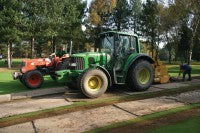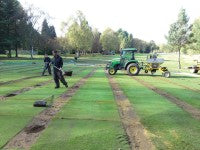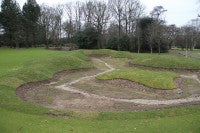Wood in the Hood!
 "This was the one area where we could make an immediate impact, by making the greens meet the demands of the modern golfer"
"This was the one area where we could make an immediate impact, by making the greens meet the demands of the modern golfer"
Golf clubs have been going through difficult times in recent years, with the current economic climate resulting in staff losses, reduced budgets and even closures. However, tough times can also bring opportunities, although bold decisions are often required.
One club that 'bit the bullet' is the Robin Hood Golf Club in Solihull which, for years, relied on the support of a healthy membership, However, with a number of pay and play golf courses springing up in the 1990s, the club soon found that their members liked the greater choice and flexibility these courses offered. In addition, through the last decade, most of the greens became unplayable in winter and during any bad weather in the summer, which also caused members to be driven away.
The club recognised that, if they wanted to compete in an ever diversifying marketplace, substantial improvements to the course were imperative. And they needed a Course Manager who could deliver their objectives.
 So, in the spring of 2009, they appointed Andy Wood to take on the job of transforming the course. He came with a great pedigree, the relevant experience and, most importantly, a vision of how he could deliver the club's expectations.
So, in the spring of 2009, they appointed Andy Wood to take on the job of transforming the course. He came with a great pedigree, the relevant experience and, most importantly, a vision of how he could deliver the club's expectations.
Andy had spent the previous seven years as Course Manager at Cosby Golf Club near Leicester, following a six-year spell at The Belfry, where he rose to the position of Deputy Head Greenkeeper.
Robin Hood is an 18 hole parkland course (6635 yards, par 72), designed by Harry Colt. It is steeped in history, with its most illustrious member being Dr. Frank Barney Gorton Stableford, creator of the Stableford scoring system, although a number of other clubs lay claim to him.
"It was the club's ambition to move forward that attracted me to the job," said Andy. "It's all about raising the profile of the golf club for everyone's benefit, and putting in place a dedicated greenkeeping team to deliver what they want."
Andy was keen to retain many of Colt's features whilst, at the same time, bringing the course up-to-date in terms of its agronomic performance, and introducing some fresh challenges for the golfers.
"The first task was to initiate an ambitious five-year plan for the course," said Andy. "One of the first things we did was to order a new fleet of course maintenance and service equipment worth over £300,000; this was bought on a John Deere Credit five-year finance package."
"It's the club's ambition to become an Open Qualifying venue and, to achieve that, a lot of things need to be put in place. Therefore, we have to upgrade every aspect of the golf course, from first impressions on arrival, through to course improvements from the tees to the greens. We'll also need to develop the club's practice facilities, to possibly include covered bays and more chipping facilities."

Andy brought in a new deputy, Luke Dennis, and a first assistant, Matt Walker, who he knew both had the skills and experience to achieve his goals. "I knew they were both capable of overseeing much of the new work required out on the course, and that's of great benefit to me"
Work began immediately to improve the drainage on the the greens. "Most are soil push up and had no drainage installed," said Andy. "This was the one area where we could make an immediate impact, by making the greens meet the demands of the modern golfer."
"The five year plan would involve the reconstruction and redesign of all tees, lengthening the course were possible, bunkers to improve the playing strategy of the course, and greens surrounds to add interest to the chip shot, and also improve course presentation. It would also mean rebuilding a couple of greens and adding additional pipe drainage across the course were necessary."

Like most innovative greenkeepers, Andy is keen to grasp new technologies and spends a lot of time researching new products and services. He uses a number of computer software packages to help produce plans, programmes of work and design.
One is called R T Landscape Manager, which has played an important part in gaining the support of the members. "It allows me to show them a 'virtual hole' so that they can easily see what the new design will look like when completed, generating a much clearer image than any drawing could."
"We obviously needed to get the work done without too much disruption to day to day play and, to help achieve this, I asked for volunteers from the membership to help with the work. This proved a successful move. The members really enjoyed the experience, with the added benefit of getting to know the greenkeeping staff and gaining a better understanding of just what goes into running and maintaining a busy golf course. This also allowed my staff to concentrate on the more major tasks."
The club employ seven greenkeeping staff - Craig Bunce, Scott Bunce, Gary Skipp and Phil Harrow, along with Andy, Luke and Matt - and one part time gardener.
 "I'm a great believer that communication between the greenkeeping team and the members makes the whole process much easier," said Andy. "With so much upheaval, it is imperative that all parties have clear information about what's going on and the implications for the course and our members."
"I'm a great believer that communication between the greenkeeping team and the members makes the whole process much easier," said Andy. "With so much upheaval, it is imperative that all parties have clear information about what's going on and the implications for the course and our members."
Andy maintains constant communication via emails, the club's website, meetings and annual presentations. "The presentations have been very successful - we had over 130 members turn up to the last one."
Andy is keen to ensure staff are well trained and motivated. "Providing good working conditions is crucial, as is an effective training programme," said Andy. Since his arrival he has introduced a new uniform, had new mess room facilities built, plus a new garage, storage bays and washdown facility. "I encourage my staff to attend industry shows and seminars and visit other golf courses. It's all part of the job and gives them a better understanding of the industry". Recent training days have included John Deere and Bernhard Grinders. "I've currently got two of my staff studying NVQ level 2 at Myerscough College as well."
Andy has also organised for his staff to have free golf lessons with the club professional.
Another new initiative has been the introduction of SOPs [Standard Operating Procedures] which the staff work to, and the members are able to read. "It's another way of communicating with the members so that they have a better understanding of the day-to-day work we undertake, but they also act as a training aid, setting out clearly what is expected for each particular task," said Andy.
The programme of work
"One of the first major jobs to be undertaken was the drainage work to the greens. They always suffered after heavy rain, and aeration and topdressing alone was never going to solve the problem," explained Andy. "After initial investigation, I drew up a plan of work and contracted Delta Golf to provide the specialist equipment needed. It was a simple case of ours and their staff working together to get the greens drained as quickly as possible."
Work began in June 2009, installing new outlets to cope with the new intensive drainage systems. Approximately 2,500m of 225/300mm perforated/solid pipe was installed to feed into the stream. A catchment drain was also installed to intercept water from the neighbouring rugby and cricket grounds that previously spilled out onto the golf course.

The next phase of the drainage scheme started in October 2009 and involved installing a new drainage scheme to the clay-based greens. "The greens were in an awful condition," explained Andy, "with large percentages of dieback from lying water, black layer rising to the surfaces and thatch levels as bad as 60mm in places. One option would have been to reconstruct, however this would have been carried out at great expense and, with other projects the club has in mind, it was not feasible.
The option I decided on, with the backing of Andy Cole from the STRI, was to begin a heavy renovation programme on the greens and the design of a grid drainage system, installing 100mm pipe at 1.5 metre centres to a minimum depth of 550mm, then sand banding at 90 degrees to the drain lines at one metre centres, with a slit width of 25mm and depth of 250mm."
Gradually, throughout the autumn of 2009, the greens were taken out of play one by one for drainage work to commence, with members having to play on temporary greens. "They were not brought back into play until the spring of 2010, once the work was completed and the greens had settled. This is where communication with our members proved so invaluable."
The Process
All the greens were surveyed using a laser level to accurately work out the best fall to drain the greens. The drains were installed at one metre centres, running front to back of the greens with drains linked into the new outfall pipes, which were laid in June.
Once the green has been surveyed and marked the turf was stripped from the earmarked, drain lines, and set aside to be put back once the drainage had been installed.
The contractors worked from boards to cause minimum disruption to the surface. They used a tractor mounted, laser guided Whiz Wheel to cut trenches approx 550mm deep, 120mm wide and at the correct fall of approx 1%. Excavated materials were taken away and stacked at a central s torage area, with the aim of using it around the course during specific repair and refurbishment work.
torage area, with the aim of using it around the course during specific repair and refurbishment work.
Once the trenches had been dug, they were backfilled with gravel, pipe and topped with 300mm depth of rootzone (sand/fensoil mix), a bridging test was carried out to ensure all materials used were compatible.
As soon as the contractor had finished the above works, Andy's staff began the final finishing off work - consolidation of rootzone materials, final levels and returfing the greens - slightly proud to allow for the inevitable settling.
Each green would take about three days to complete, weather dependant, with one extra day put aside for secondary drainage, if required.
Sand banding is a secondary drainage technique, installing slits 25mm wide approx 200mm deep, back filling with sand as the machine makes the pass. The slits were installed at one metre spacings.
Andy then carried out cultural practices to help the greens recover - hollow tining, vertidraining between drainage lines, topdressing and rolling, with the aim of getting the greens back in play as soon as possible.
 By April 2010, Andy had completed work on sixteen greens, along with the complete rebuild of the 1st hole. This saw a complete new green layout, with new bunkers around the green, and in the fairway, to add interest and improve the strategy of playing the hole.
By April 2010, Andy had completed work on sixteen greens, along with the complete rebuild of the 1st hole. This saw a complete new green layout, with new bunkers around the green, and in the fairway, to add interest and improve the strategy of playing the hole.
Once the playing season started, Andy and his staff concentrated on keeping the course presentable, and carried on with intensive aeration and topdressing on the newly drained greens, applying over 400 tonnes of sand in the first year, adding a further 400 tonne in the following ten months.
October 2010 saw the return of Delta Golf to start another programme of work for the club. This involved earth moving and reshaping of the 16th green, plus a number of new tees.

"I wanted to create a new signature hole," said Andy. "One that brought a complete new look to the course and a fresh challenge for golfers."
"So, work is currently ongoing to create a large water feature set around a challenging green, protected by new bunkers and a backdrop of rhododendrons - they will offer grand displays of colour in May and June."
All of the new turf used was supplied by Inturf, with any old turf being reused in other areas.
The work ethic of Andy and his staff is exceptional. They have achieved an incredible amount in the last two years, and there's still three years to go with the plan!
When I spoke to a couple of club members, they were keen to sing the praises of the staff and were clearly enthralled by what was going on at 'their' club.
Putting up with all the mess and disruption that comes with major work may have proved difficult but, with members already seeing the benefit of the drainage programme, and the greens now back in play and performing well, further work will be both tolerated and welcomed.
As Andy says, first and last impressions of the course are very important. Robin Hood Golf Club is certainly being brought into the 21st century.
